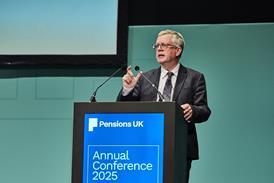The Local Government Pension Scheme has a big year ahead but how have recent developments changed the forward trajectory for local authority funds?
The market value of the Local Government Pension Scheme surpassed £200bn in the year to March – a juicy and low-hanging fruit, ripened just in time for George Osborne’s grand infrastructure vision.
A statistical release from the Department for Communities and Local Government last week showed the scheme’s 13 per cent growth had offset rising expenditure across administration and benefits over the same period.
However, costs charged to the funds increased by £238m, or 42 per cent, during the year to £810m.
Out of context, the figure leaps straight into the hands of the scheme’s fiercest critics, adding fuel to the engine driving towards asset pooling and passive mandates.
New regime
The DCLG attributes the sharp rise to new accounting practices adopted by many funds during the year in response to Chartered Institute of Public Finance and Accounting guidance in 2014.
CIPFA issued the guidance in response to Hymans Robertson’s structural analysis of the LGPS, commissioned by DCLG and released in 2013.
Nigel Keogh, pensions technical manager at CIPFA, says the new reporting regime is the primary reason for the increase in fund management costs and has improved transparency of disclosure on funds of funds and pooled investment vehicles.
“We have got a very different reporting and disclosure regime now emerging in the LGPS,” he says, adding that the precise number of schemes implementing the new guidelines would become clear as schemes issue their annual reports.

“Given we are in the process of making some significant policy decisions on the future structure of LGPS pension funds based around what it is costing to manage them, it is rather more important that we get a thorough understanding of what those costs are.”
Improved disclosure and reporting will help the scheme breach the impasse on active versus passive management and provide some “hard data” for analysis of scheme costs prior to the wholesale shift towards pooling, Keogh says.
“Whether or not that strengthens the case of pooling I can’t say but… I hope it helps to inform the debate on being able to form a value judgment over which investments offer value for money.”
Hugh Grover, chief executive officer at the London Collective Investment Vehicle, says investment management fees in the LGPS have been trending downward.
It will be very interesting to see how the government works with the LGPS to deliver what works for funds [in terms of infrastructure]
Hugh Grover, London CIV
“If the underlying change in the numbers this year is down to an accounting process, one would need to compare like-for-like the extent to which fees have actually gone up,” he says. “Otherwise you’re not comparing apples with apples.”
Grover anticipates the shift to collaborative investing could reduce the scheme’s investment management spend by 20-30 per cent.
“We ought to be seeing at least that, if not more, as the various collaborative arrangements come into place,” he says, adding that it is too early to stump up an accurate figure for potential cost savings.
Based on Grover’s estimate, a 25 per cent reduction in fees would have saved the scheme between £162m and £243m during the year to March.
Pooling plans
The run-up to Christmas will have some added pressure for LGPS scheme managers across the country as they await the government’s consultation on pooling.
After digesting the proposals, funds must respond with their plans by February.
“Funds need to be moving down the track pretty swiftly now to have firm plans in place to go back to government in February,” says Grover.
With few clear guidelines, the LGPS has been tasked with revolution – to go out into the market and negotiate a new structural framework for the £200bn scheme.
At the Local Government Pension Investment Forum last month just 16 per cent of scheme delegates had a firm idea of their plans for pooling, with remaining attendees evenly split between having a vague idea and not knowing at all the direction of travel for their fund (see graph, left).
Nearly eight in 10 delegates (79 per cent) deemed the chancellor’s plans for infrastructure correct in principle but “simply ill conceived” while 62 per cent thought it unlikely Osborne’s vision for six functioning pools of assets would come to fruition within the next five years.
Regional seems ad hoc. More important is finding a group of funds who can work together quickly, are like-minded and can put a business case together
Jo Holden, Mercer
Speaking at the forum Jo Holden, head of consultancy Mercer’s local authority investment business, questioned whether regional pooling was a step in the right direction for the scheme.
“Regional seems ad hoc,” she said. “More important is finding a group of funds who can work together quickly, are like-minded and can put a business case together.”
Holden sees two timescales in play en route to pooling; one for funds to collaborate and put forward a proposal, and another longer-term trajectory for transition and implementation.
Having conversations and talking through ideas with colleagues across the scheme will be crucial to making progress over the coming weeks and months, she said.
Approaching valuations
Next year’s triennial valuation will be a key marker for the scheme’s future as current historic lows in yields wreak havoc for funding levels across the public and private sectors.
Speaking at the LGPIF, Graeme Muir, partner and head of public sector consulting at Barnett Waddingham, said he aims to make the process as “unexciting” as possible.
But as actuaries and funds dig down into the numbers and forge a strategy for the next three years, the spectre of standardisation looms over the process.
Muir urged caution around moves to standardise. “Be careful what you wish for,” he said. “We’ve had attempts at standardisation in the past with some pretty horrendous consequences,” he added, citing the introduction of minimum funding requirements in the wake of the Maxwell scandal.
“The MFR was brought in to establish a minimum level of funding… that minimum then became the target.”
Seven in 10 (72 per cent) delegates at the LGPIF said standardisation would be a positive for the scheme while nine in 10 (89 per cent) said more transparency is needed around the actuarial bases.
John Wright, partner and head of public sector at consultancy Hymans Robertson, also speaking at the forum, is against standardisation of contributions, but in favour of using standard metrics for the purpose of making comparisons between funds.
“We should be able to see how credible a fund’s combined contribution and investment strategy is,” said Wright.
“How credible is the plan to deal with the deficit? How likely is it to work?”






















